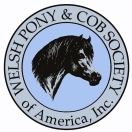


Section C Welsh ponies of Cob type, having all the attributes of the Mountain Pony, are, in effect, slightly larger, heavier versions. Many were used originally for every sort of work on the Welsh Hill Farms, as well as being employed in the coal mines (as were the Mountain ponies). After World War II, when the type seemed in danger of disappearing, a new section was opened in the British Studbook to preserve them. Naturally courageous and good jumpers, they make wonderful hunting, trail, or harness ponies.
Maximum Height:13:2 hands
Breed Description: General Character: Strong, hardy and active, with pony character and as much substance as possible. Color: Any color. Head: Full of quality and pony character. A coarse head and Roman nose are most objectionable. Eyes: Bold, prominent and set widely apart. Ears: Neat and well-set. Neck: Lengthy and well-carried. Moderately lean in the case of mares, but inclined to be cresty in the case of mature stallions. Shoulders: Strong but well laid back. Forelegs: Set square and not tied in at the elbows. Long, strong forearms. Knees well-developed with an abundance of bone below them. Pasterns of proportionate slope and length. Feet well shaped. Hooves dense. When in the rough, a moderate quantity of silky feather is not objected to but course, wiry hair is a definite objection. Middlepiece: Back and loins muscular, strong and well-coupled. Deep through the heart and well ribbed up. Hind Quarters: Lengthy and strong. Ragged or drooping quarters are objectionable. Tail well set on. Hind Legs: Second thighs, strong and muscular. Hocks large, flat and clean, with points prominent, turning neither inward nor outward. The hind legs must not be too bent and the hock not set behind a line falling from the point of the quarter to the fetlock joint. Pasterns of proportionate slope and length. Feet well-shaped, hooves dense. Action: Free, true and forcible. The knee should be bent and the whole foreleg should be extended straight from the shoulder and as far forward as possible in the trot. Hocks flexed under the body with straight and powerful leverage.


